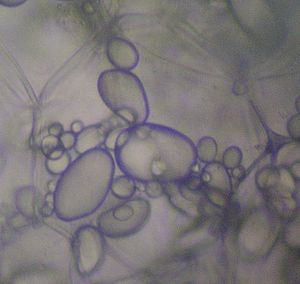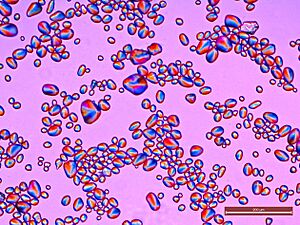Potato starch facts for kids
Potato starch is a type of starch that comes from potatoes. Inside potato plants, the root tubers (the potatoes themselves) have tiny storage units called leucoplasts. These leucoplasts are packed with starch grains.
To get the starch, potatoes are crushed. This breaks open the cells and releases the starch grains. The starch is then separated from the water, often using special machines called hydrocyclones. Finally, it's dried into a fine powder.
Potato starch looks like tiny oval or round grains. They can be from 5 to 100 micrometers big. (A micrometer is super tiny, much smaller than a speck of dust!) It's a very pure starch, with almost no protein or fat. This makes it a bright white powder. When cooked, it has a neutral taste, looks clear, and is great for thickening things. It also doesn't foam much or turn yellow.
Potato starch naturally contains a small amount of phosphate. This makes it extra thick and gives it a slightly negative electrical charge. It also starts to thicken at a lower temperature, around 60 °C (140 °F), and can swell a lot. These special features make it useful in many foods and other products.
Contents
What is Potato Starch Used For?
Potato starch is used in many different ways, both in food and other products.
In Food
You can find potato starch in lots of recipes and packaged foods. It's often used to make:
- Noodles
- Wine gums
- Cocktail nuts
- Potato chips
- Hot dog sausages
- Bakery creams
- Instant soups and sauces
It's also a key ingredient in gluten-free recipes. For example, it's used in kosher foods for Passover and in many dishes from Asian cuisine. In baking, like for sponge cake, potato starch helps keep the cake moist and gives it a soft texture. Sometimes, it's added to pre-packed grated cheese to stop it from sticking together and sweating.
Other special foods made with potato starch include:
- Helmipuuro: A porridge from Finland made with potato starch grains and milk.
- Papeda: A dish from the Moluccan islands, where potato starch is used to make a thick, gluey food.
Beyond Food
Potato starch isn't just for eating! It has many non-food uses too, such as:
- Wallpaper adhesive: It helps wallpaper stick to walls.
- Textile finishing and textile sizing: It's used to make fabrics stronger and smoother.
- Paper coating and sizing: It helps make paper stronger and smoother for printing.
- Adhesive: It's used in paper sacks and gummed tape.
Interestingly, potato starch was even used in one of the first color photography methods. This was called the Autochrome Lumière, invented by the Lumière brothers. It was used until newer color films came out in the 1930s.
Potato Varieties for Starch

Farmers grow specific types of potatoes just for making starch. They choose potato varieties that have a lot of starch and give a high yield.
Recently, scientists developed a new type of potato plant. This plant produces only one kind of starch molecule called amylopectin. This special starch is known as waxy potato starch. When waxy starches are cooked and then stored, they don't get as hard or stiff as regular starches.
Most of the world's potato starch is made in countries like Germany, the Netherlands, China, Japan, France, Denmark, and Poland. It's also produced in Sweden, Finland, Austria, the Czech Republic, Ukraine, Canada, and India.
Some potato starch is also collected as a side product from factories that process potatoes. For example, when French fries or potato chips are made, starch can be recovered from the water used to cut the potatoes.
How to Identify Potato Starch
If you look at potato starch under a microscope, you'll see clear, colorless grains. They are usually oval or pear-shaped, but can also be round. They are typically 30 to 100 micrometers in size, but some can be even bigger.
When viewed under a special microscope with polarized light, potato starch grains show a unique dark cross pattern. This helps scientists identify them. Also, if you get potato starch wet, it becomes very sticky!
See also
 In Spanish: Almidón de papa para niños
In Spanish: Almidón de papa para niños




